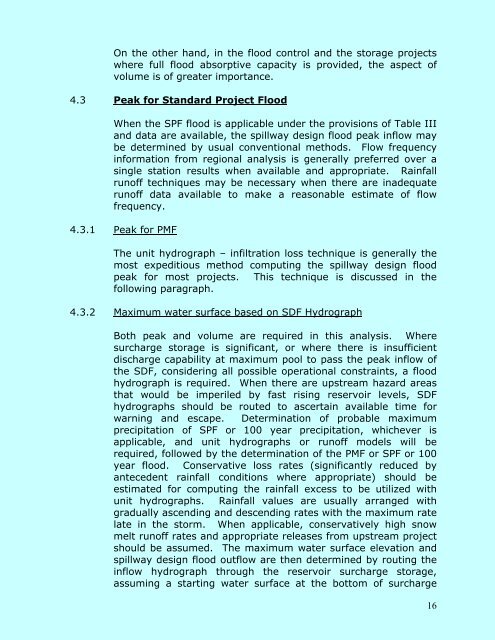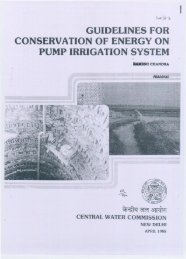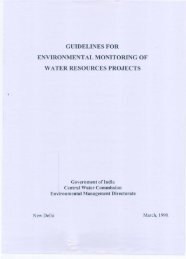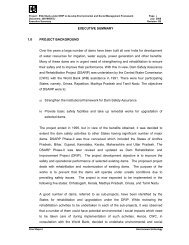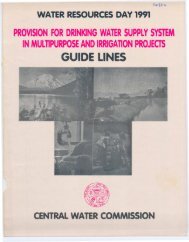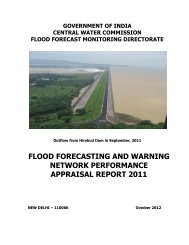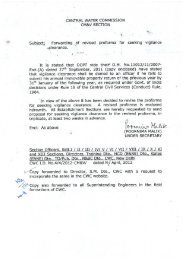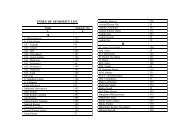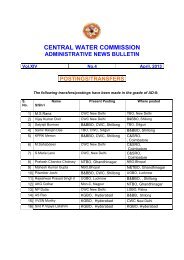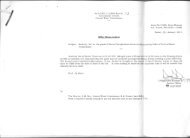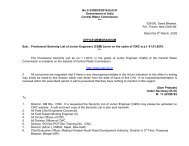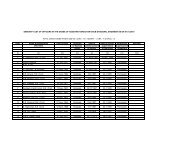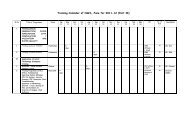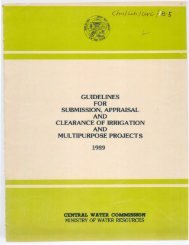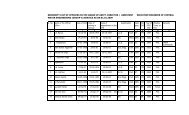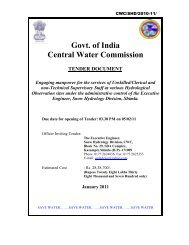Guidelines for Safety Inspection of Dams - Central Water Commission
Guidelines for Safety Inspection of Dams - Central Water Commission
Guidelines for Safety Inspection of Dams - Central Water Commission
Create successful ePaper yourself
Turn your PDF publications into a flip-book with our unique Google optimized e-Paper software.
On the other hand, in the flood control and the storage projects<br />
where full flood absorptive capacity is provided, the aspect <strong>of</strong><br />
volume is <strong>of</strong> greater importance.<br />
4.3 Peak <strong>for</strong> Standard Project Flood<br />
When the SPF flood is applicable under the provisions <strong>of</strong> Table III<br />
and data are available, the spillway design flood peak inflow may<br />
be determined by usual conventional methods. Flow frequency<br />
in<strong>for</strong>mation from regional analysis is generally preferred over a<br />
single station results when available and appropriate. Rainfall<br />
run<strong>of</strong>f techniques may be necessary when there are inadequate<br />
run<strong>of</strong>f data available to make a reasonable estimate <strong>of</strong> flow<br />
frequency.<br />
4.3.1 Peak <strong>for</strong> PMF<br />
The unit hydrograph – infiltration loss technique is generally the<br />
most expeditious method computing the spillway design flood<br />
peak <strong>for</strong> most projects. This technique is discussed in the<br />
following paragraph.<br />
4.3.2 Maximum water surface based on SDF Hydrograph<br />
Both peak and volume are required in this analysis. Where<br />
surcharge storage is significant, or where there is insufficient<br />
discharge capability at maximum pool to pass the peak inflow <strong>of</strong><br />
the SDF, considering all possible operational constraints, a flood<br />
hydrograph is required. When there are upstream hazard areas<br />
that would be imperiled by fast rising reservoir levels, SDF<br />
hydrographs should be routed to ascertain available time <strong>for</strong><br />
warning and escape. Determination <strong>of</strong> probable maximum<br />
precipitation <strong>of</strong> SPF or 100 year precipitation, whichever is<br />
applicable, and unit hydrographs or run<strong>of</strong>f models will be<br />
required, followed by the determination <strong>of</strong> the PMF or SPF or 100<br />
year flood. Conservative loss rates (significantly reduced by<br />
antecedent rainfall conditions where appropriate) should be<br />
estimated <strong>for</strong> computing the rainfall excess to be utilized with<br />
unit hydrographs. Rainfall values are usually arranged with<br />
gradually ascending and descending rates with the maximum rate<br />
late in the storm. When applicable, conservatively high snow<br />
melt run<strong>of</strong>f rates and appropriate releases from upstream project<br />
should be assumed. The maximum water surface elevation and<br />
spillway design flood outflow are then determined by routing the<br />
inflow hydrograph through the reservoir surcharge storage,<br />
assuming a starting water surface at the bottom <strong>of</strong> surcharge<br />
16


